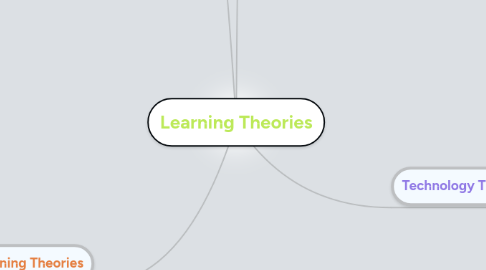
1. Learning Theories
1.1. Connectivism
1.1.1. Basic Principles
1.1.1.1. New Theory (2006): A learning theory for the digital age
1.1.1.2. Learning is the process of creating connections and developing a network
1.1.1.3. The ability to retrieve information is valued rather than actually knowing the information
1.1.1.4. Requires active participation
1.1.1.5. Ability to see connections between fields, ideas and concepts is a core skill
1.1.1.6. Maintaining connections is needed to facilitate continual learning
1.1.1.7. Examples
1.1.1.7.1. Blogs (GoogleSites, Wordpress, Blogspot)
1.1.1.7.2. Online learning (eClass, MOOCs)
1.1.2. Implications for Educators
1.1.2.1. Must teach critical thinking when it comes to retrieving information
1.1.2.2. Help students to connect to others for help and discussion
1.1.2.3. Help students to find online networking and help them to nurture these connections to further facilitate learning
1.2. Constructivist
1.2.1. Basic Principles
1.2.1.1. The mind is like a rhizome
1.2.1.2. Building connections by interacting with the environment
1.2.1.3. Problem & Project based learning
1.2.1.4. Learning based on collaborating and discovery
1.2.1.5. "Learning by creating"
1.2.1.6. Examples
1.2.1.6.1. Experiments
1.2.1.6.2. Hands-on classwork
1.2.2. Implications for Educators
1.2.2.1. Teachers act as facilitators
1.2.2.2. Through discussion students will gain knowledge & understanding
1.2.2.3. Allows for creative expression (individuality)
1.2.2.4. We are not necessarily after the right "answer", the process to the answer is what we are interested in (analyzing)
1.3. Cognitive Load
1.3.1. Basic Principles
1.3.1.1. Examples
1.3.1.1.1. Chunking
1.3.1.1.2. Mind Mapping
1.3.1.2. Memory systems are active, organized processors of information
1.3.1.3. Prior knowledge is key in learning
1.3.1.4. Schema/Scaffolding
1.3.1.5. Mind can be underloaded/overloaded
1.3.1.6. Working memory can only process so much information
1.3.2. Implications for Educators
1.3.2.1. Educators must be careful to not overload the students working memory
1.3.2.2. Must also be careful to not under-stimulate the students working mind
1.3.2.3. Find a balance between how much information a student can retain and work on
2. TPACK
2.1. A teacher must possess 3 things
2.1.1. Pedagogical Knowledge (PK)
2.1.1.1. Knowing what you are actually supposed to teach (curriculum & outcomes)
2.1.2. Pedagogical Knowledge (PK)
2.1.2.1. How will you teach the content? Techniques, methods, etc.
2.1.2.2. Are the strategies I'm using appropriate for this content?
2.1.2.3. Are there other strategies that others are using?
2.1.3. Technology Knowledge (TK)
2.1.3.1. The ability to use technology in a classroom
2.1.3.2. Example: scientific caltulator
2.1.3.3. Subject specific technology
2.2. A venn diagram is used to demonstrate how the three can be linked and overlapped together
3. Technology Theories
3.1. SCOT (Social Construction of Technology
3.1.1. Basic Principles
3.1.1.1. Human action creates progression in technology, not the other way around
3.1.1.2. One must be able to understand the social context of technology
3.1.1.3. Relevancy is key; to make a website for someone who does not use a computer would be pointless
3.1.1.4. Interpretive flexibility: different types of technology has different meanings for different people
3.1.2. Implications for Teachers
3.1.2.1. Must be up to date on technology, using what is fresh and exciting in classrooms is key
3.1.2.2. Keep social contexts in mind when using technology in the classroom
3.1.2.3. Know what will work - a student is more likely to set up a Facebook account than a blog
3.2. Media Ecology
3.2.1. Basic Principles
3.2.1.1. The opposite of the SCOT model
3.2.1.2. Life & society is influenced by technology
3.2.1.3. The world is connected by the media
3.2.1.4. Media alters the way we perceive and think about our world, brings other perspectives into play
3.2.1.5. Media: HOT or COLD
3.2.1.5.1. HOT: Communication with little involvement from the audience
3.2.1.5.2. COLD: Media that requires involvement from the audience
3.2.2. Implications for Educators
3.2.2.1. Media is an incredibly important tool in the classroom and should not be passed over
3.2.2.2. In this day and age, educators must have a strong grasp on media and technology
3.2.2.3. Understanding technology helps us to understand what our students see on a daily basis
